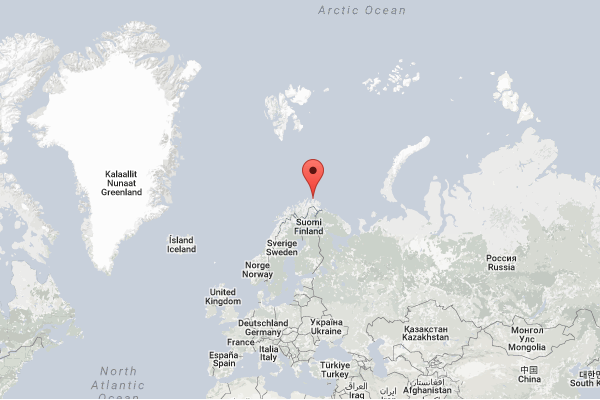World War II and the burning of Finnmark
Norway was under German occupation during most of World War II. In September 1944, the truce between Finland and the Soviet Union forced the Nazi army to make hasty plans for a withdrawal of their forces from the Murmansk Front all the way
through Finnmark to northern Troms County.
Operation Nordlicht (Operation Northern Lights) was initiated on the direct order of the Führer himself in October 1944, and called for the immediate forced evacuation of the
civilian population of Finnmark, as well as scorched earth tactics. The Soviet Red Army was to be given no resources from Finnmark on their westward advance, and nearly all settlements were
demolished or burned to the ground. Some 17,000 buildings (including over 100 schools) were razed, in addition to several hundred roads, bridges, boats, vehicles and lighthouses.
A staggering number of livestock were also killed during the retreat.
![Aarsaether]()
Burned fish factory in Kjøllefjord. Photo: Edm. Wallenius
Around 25,000 of Finnmark's population of 60,000 escaped the evacuation and took refuge in caves, earth-roofed huts and abandoned boats. Those who spent the winter of 1944/1945 as
refugees in the wilderness became known as "the Cave Dwellers", and survived by fishing, slaughtering any remaining livestock and flour from local merchants.
The first Allied aid supplies arrived in March 1945. About 300 people died as a result of the harsh winter or from the evacuation itself.
A few places in Finnmark were spared the flames, such as Båtsfjord, Bugøynes and Hamningberg. Bugøynes was saved from destruction because of an agreement between the the German officer Peter Paul Flach and the
local population. A few churches in Alta, Honningsvåg, Karasjok and Kistrand were also preserved.
Nordkinn, however, was not among the lucky places. Virtually every structure in the region was destroyed.
"I am just a child, so I don't understand much about the world.
But do any of the grown-ups understand what harm we are supposed to have done to these nasty people who have destroyed our beloved homes?"
- A 13-year-old girl from Finnmark, in a school paper written after the evacuation
Liberation by the Red Army
The Red Army crossed the Norwegian border at Kirkenes in October 1944, and initially there was uncertainty as to how far the Soviets would advance and how long they would remain.
Some fears were allayed on October 25, when Kirkenes was liberated and thousands of inhabitants sheltered in a mine tunnel were told by Soviet soldiers: "Raise the Norwegian flag, for now you are free".
The Soviets halted their advancement at the Tana river in eastern Finnmark.
![Liberation]()
Parading the Norwegian flag after liberation of Kirkenes. Photo: Finnmark Fylkesbibliotek
On May 8, 1945, German capitulation ensured a liberated Norway. The last Soviet troops left Norway on September 25, 1945, by order of the Soviet government. The liberated population of Finnmark
reported that they had been treated well by Soviet troops, in contrast to the treatment they received by the largely symbolic Norwegian detachment of troops sent to assist in the liberation.
Norwegian forces from southern parts had trouble comprehending that Finnmark, with a population of 60,000, had been occupied by around 200,000 German troops. The Germans were not interspersed among
the local population like they were in southern parts of Norway, but completely dominated society. The conditions for guerrilla warfare were not present, and the two populations had to find ways to cooperate
in order for society to function.
This resulted in accusations of disloyalty against the Finnmark population, and especially against women who had engaged in relationships with the occupiers. Many were publicly shamed by having their hair cut or shaved.
To add insult to injury, resistance groups from Finnmark who in fact had worked against the German occupation were not recognised until the 1980's. For obvious reasons they had to
cooperate with the Soviets (there were no Allied forces to cooperate with), and with the onset of the Cold War any previous association with Soviets resulted in distrust and suspicion.
Remnants of a longstanding divide between North and South exist today. Some government representatives still express doubts about the loyalty of Finnmark inhabitants
based on strong relationships with Russia. This is of course rubbish, but illustrates that there was and still is a large degree of ignorance about conditions in Finnmark on the part of central authorities.
Reconstruction of Finnmark
After the war, the government tried to prohibit the immediate return of evacuees to Finnmark, in order to organise the reconstruction and avoid casualties due to possible mine fields.
The prohibition was widely ignored, and by 1946 about 90% of the population had returned to their home towns. This was problematic because of a severe shortage of materials, transport, craftsmen and funds.
Official reconstruction began in 1947 and continued in full force until around 1960. A majority of the current buildings in Finnmark are from this period.






















